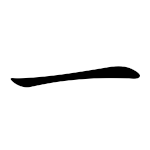

| 一 | ||||
|---|---|---|---|---|
| ||||
| 一 (U+4E00) "one" | ||||
| Pronunciations | ||||
| Pinyin: | yī | |||
| Bopomofo: | 一 | |||
| Gwoyeu Romatzyh: | i | |||
| Wade–Giles: | i1 | |||
| Cantonese Yale: | yāt | |||
| Jyutping: | jat1 | |||
| Pe̍h-ōe-jī: | it | |||
| Japanese Kana: | イチ ichi (on'yomi) ひと(つ) hito(tsu) (kun'yomi) | |||
| Sino-Korean: | 일il | |||
| Hán-Việt: | 一 nhất | |||
| Names | ||||
| Chinese name(s): | 橫/横 héng | |||
| Japanese name(s): | 一 ichi | |||
| Hangul: | 한 han | |||
| Stroke order animation | ||||
 | ||||
Radical 1orradical one (一部) meaning "one" is one of the 6 Kangxi radicals (214 radicals in total) composed of 1 stroke. It is the simplest Chinese character in the language due to consisting of only one line.
In the Kangxi Dictionary, there are 60 characters (out of 47,043) to be found under this radical.[1]
一 is also the 1st indexing component in the Table of Indexing Chinese Character Components predominantly adopted by Simplified Chinese dictionaries published in mainland China.

| Strokes | Characters[a] |
|---|---|
| +0 | 一 |
| +1 | 丁 丂 七 丄 丅 丆 |
| +2 | 万 (also SC/JP form of 萬 -> 艸) 丈 三 上 下 丌 与SC/与JP (also SC/JP form of 與 -> 臼) |
| +3 | 不 丏 丐 丑SC/JP/丑TC (also SC form of 醜 -> 酉) 丒 (=丑) 专SC (=專 -> 寸) |
| +4 | 且 丕 世 丘 丙 业SC (=業 -> 木) 丛SC (=叢 => 又) 东SC (=東 -> Radical 75) 丝SC (=絲 -> 糸) |
| +5 | 丞 丟 丠 両JP (=兩 -> 入) |
| +6 | 丣 两SC (=兩 -> 入) 严SC (=嚴 -> 口) |
| +7 | 並 丧SC (=喪 -> 口) |

The only stroke in radical one, known as 橫/横 héng "horizontal", is called 策 cè in the eight principles of the character 永 (永字八法 Yǒngzì Bāfǎ) which are the basis of Chinese calligraphy.
As an isolated character it is one of the Kyōiku kanji or Kanji taught in elementary school in Japan.[2] It is a first grade kanji.[2]
{{cite book}}: CS1 maint: location missing publisher (link)|
Chinese radicals according to the Kangxi Dictionary
| |
|---|---|
| 1 stroke |
|
| 2 strokes |
|
| 3 strokes |
|
| 4 strokes |
|
| 5 strokes |
|
| 6 strokes |
|
| 7 strokes |
|
| 8 strokes |
|
| 9 strokes |
|
| 10 strokes |
|
| 11 strokes |
|
| 12 strokes |
|
| 13 strokes |
|
| 14 strokes |
|
| 15 strokes |
|
| 16 strokes |
|
| 17 strokes |
|
See also: Kangxi radicals | |
|
Simplified Chinese characters radicals (indexing components)
| |
|---|---|
| 1 stroke |
|
| 2 strokes |
|
| 3 strokes |
|
| 4 strokes |
|
| 5 strokes |
|
| 6 strokes |
|
| 7 strokes |
|
| 8 strokes |
|
| 9 strokes |
|
| 10 strokes |
|
| 11 strokes |
|
| 12 strokes |
|
| 13 strokes |
|
| 14 strokes |
|
| 17 strokes |
|
GF 0011-2009 Table of Indexing Chinese Character Components prescribes 201 principle indexing components and 100 associated indexing components (in brackets) used in Simplified Chinese. Not all associated indexing components are listed above. | |